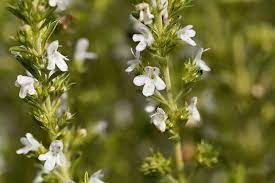Last Updated on April 15, 2024 by Real Men Sow
Growing Winter savory from seed is easy. It’s best to start it indoors in late winter or early spring, before the ground warms up too much for it to survive outdoors. Winter savory is a perennial herb. Its leaves and flowers taste spicy and peppery like its annual relative, summer savory. Summer savory tastes milder, sweeter, or more pleasant in cooked dishes. But winter savory is also recommended in bean dishes, stuffings, etc. It is sometimes used to flavor liqueurs.
Winter savory also has a variety of medicinal uses. It can aid digestion and reduce flatulence. Some studies also suggest that it can be helpful against problems ranging from bad breath to cancer.
When and How to Plant Winter Savory
Growing Winter Savory From Seed
It is best to start winter savory plants from seeds within 6-8 weeks of the last spring frost. The seeds need light to germinate so don’t cover them with soil. They germinate at 60-70°F.
Planting Seedlings in the Garden
After the last frost has passed, transplant seedlings outdoors. Place them in well-drained soil. You may also be able to divide root roots in spring or fall if your winter savory has gotten out of control.
General Care Guide for Growing Winter Savory
Winter savory, like most plants, needs regular watering. It thrives if it has at least one inch of water per week. Overwatering is more dangerous than underwatering and can cause the plant’s to become rotted. Plant Winter savory in well-drained soil, and not being mulched.
Winter savory is a light-feeder and doesn’t need much fertilization. For a micronutrient boost, you might spray it twice or three times with seaweed extract during the growing season.
Over time, the plants may become woody. You can prevent this by trimming the plants before they open. According to the Herb Society of North America, you should not cut more than one third of the plant at a time.
The top half of the plant will be cut off in the middle of the summer or early fall to prevent flowering. Try different things to find what works best for you.
Container Growing
Winter savory can also grow in containers, indoors and outdoors. Containers should be at least 6 inches in depth.
Common Problems With Growing Winter Savory
Winter savory is relatively trouble-free. It is not susceptible to any diseases or pests, according to some sites. Do not over water and under ventilate seedlings to prevent damping-off, a form of soft stem rot. Rhizoctonia is a root rot that can be caused by overwatering older plants in poor or heavy soils. You’ll be fine if you keep your plants well-drained.
Propagation
Winter savory can also be grown from cuttings. Gardeners should plant cuttings in fall or winter. However, northern gardeners might need to use a different time frame and take cuttings in the summer.
Trim a section of 3-5 inches from the stem just above a leaf joint. Cut to the point where the leaf joint is the lowest. Take off 1/3 of the stem, and then bury the section in a moist mixture. The plants should be allowed to grow in a bright area, but not in full sunlight.
Winter savory cuttings can form roots in about 4-6 weeks. After that, you can transplant them. It is also possible to divide root clumps from winter savory plants.
Harvest
Cut stems right before the plant flowers to preserve them. Leaf flavor is best when it’s still young. Winter savory will thrive if the stems are cut in the fall. Depending on where you get it from, you can take 1/3 to 1/2 of the plant. You can save a few tips for future use.
Winter savory should be harvested in the morning after the dew has melted but before it gets too hot.
Storing Fresh Winter Savory
Winter savory can be kept fresh for many days in the refrigerator if it is placed in a glass of water and covered with a plastic bag. Winter Savory is very dry. The stems can be wrapped and hung or laid on a screen. You can dry them in a cool place, with low humidity, and out of direct sun. Once the leaves become brittle, remove them and store them in an airtight container. Winter savory can be stored for up to one year if dried properly.
Steps in Preserving Winter Savory
- Cover the jar with 1/3 to 1/2 cup winter savory (or 3/4 for milder-flavored summer salt) and seal it with vinegar.
- To prevent corrosion, cover the jar with 2 layers of plastic wrap.
- Keep it in a dark area for between 10-14 days until you get the desired flavor.

